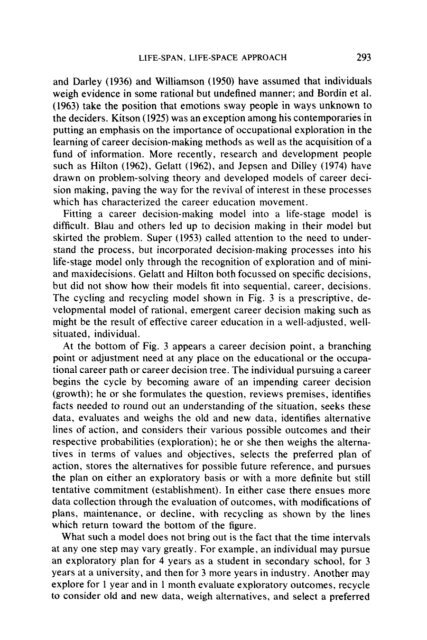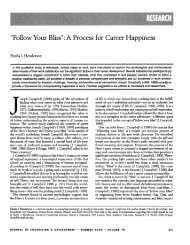A Life-Span, Life-Space Approach to Career Development
A Life-Span, Life-Space Approach to Career Development
A Life-Span, Life-Space Approach to Career Development
You also want an ePaper? Increase the reach of your titles
YUMPU automatically turns print PDFs into web optimized ePapers that Google loves.
LIFE-SPAN. LIFE-SPACE APPROACH 293<br />
and Darley (1936) and Williamson (1950) have assumed that individuals<br />
weigh evidence in some rational but undefined manner; and Bordin et al.<br />
(1963) take the position that emotions sway people in ways unknown <strong>to</strong><br />
the deciders. Kitson (1925) was an exception among his contemporaries in<br />
putting an emphasis on the importance of occupational exploration in the<br />
learning of career decision-making methods as well as the acquisition of a<br />
fund of information. More recently, research and development people<br />
such as Hil<strong>to</strong>n (1962), Gelatt (1962), and Jepsen and Dilley (1974) have<br />
drawn on problem-solving theory and developed models of career deci-<br />
sion making, paving the way for the revival of interest in these processes<br />
which has characterized the career education movement.<br />
Fitting a career decision-making model in<strong>to</strong> a life-stage model is<br />
difficult. Blau and others led up <strong>to</strong> decision making in their model but<br />
skirted the problem. Super (1953) called attention <strong>to</strong> the need <strong>to</strong> under-<br />
stand the process, but incorporated decision-making processes in<strong>to</strong> his<br />
life-stage model only through the recognition of exploration and of mini-<br />
and maxidecisions. Gelatt and Hil<strong>to</strong>n both focussed on specific decisions,<br />
but did not show how their models fit in<strong>to</strong> sequential, career, decisions.<br />
The cycling and recycling model shown in Fig. 3 is a prescriptive, de-<br />
velopmental model of rational, emergent career decision making such as<br />
might be the result of effective career education in a well-adjusted, well-<br />
situated, individual.<br />
At the bot<strong>to</strong>m of Fig. 3 appears a career decision point, a branching<br />
point or adjustment need at any place on the educational or the occupa-<br />
tional career path or career decision tree. The individual pursuing a career<br />
begins the cycle by becoming aware of an impending career decision<br />
(growth); he or she formulates the question, reviews premises, identifies<br />
facts needed <strong>to</strong> round out an understanding of the situation, seeks these<br />
data, evaluates and weighs the old and new data, identifies alternative<br />
lines of action, and considers their various possible outcomes and their<br />
respective probabilities (exploration); he or she then weighs the alterna-<br />
tives in terms of values and objectives, selects the preferred plan of<br />
action, s<strong>to</strong>res the alternatives for possible future reference, and pursues<br />
the plan on either an explora<strong>to</strong>ry basis or with a more definite but still<br />
tentative commitment (establishment). In either case there ensues more<br />
data collection through the evaluation of outcomes, with modifications of<br />
plans, maintenance, or decline, with recycling as shown by the lines<br />
which return <strong>to</strong>ward the bot<strong>to</strong>m of the figure.<br />
What such a model does not bring out is the fact that the time intervals<br />
at any one step may vary greatly. For example, an individual may pursue<br />
an explora<strong>to</strong>ry plan for 4 years as a student in secondary school, for 3<br />
years at a university, and then for 3 more years in industry. Another may<br />
explore for 1 year and in 1 month evaluate explora<strong>to</strong>ry outcomes, recycle<br />
<strong>to</strong> consider old and new data, weigh alternatives, and select a preferred



